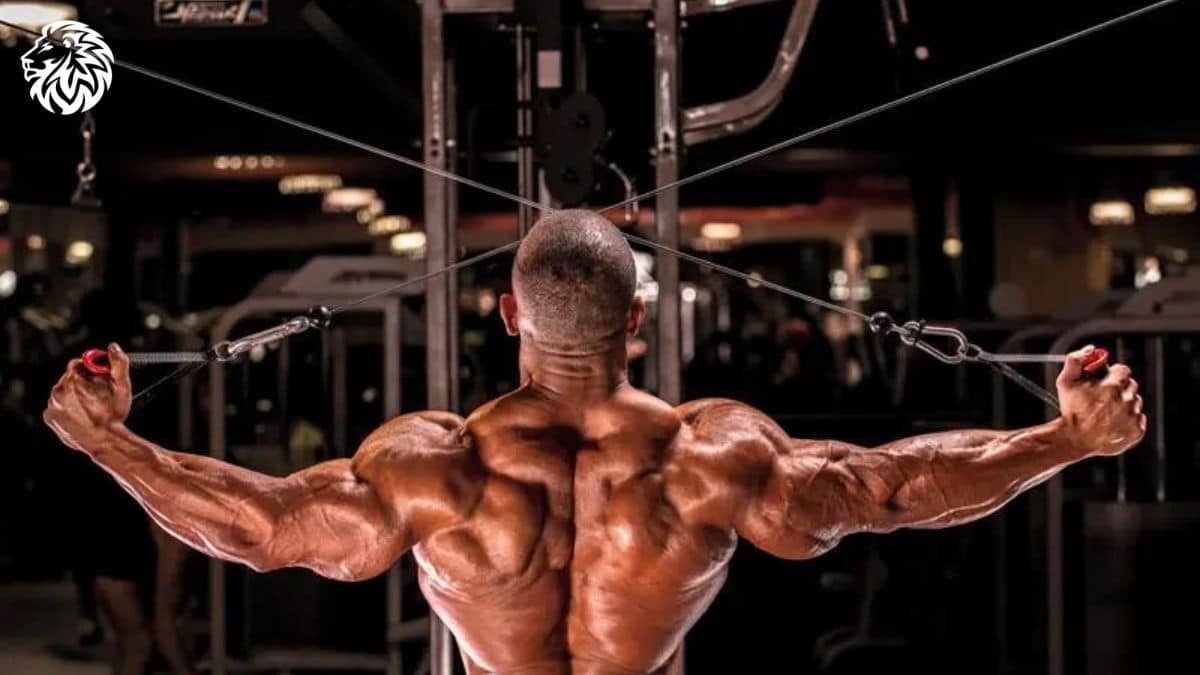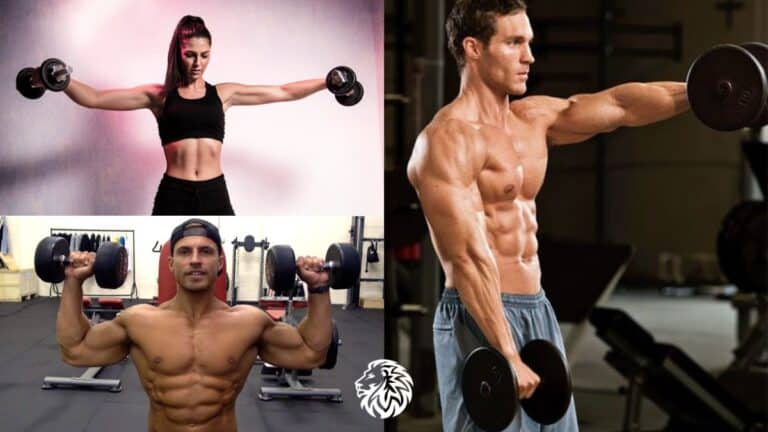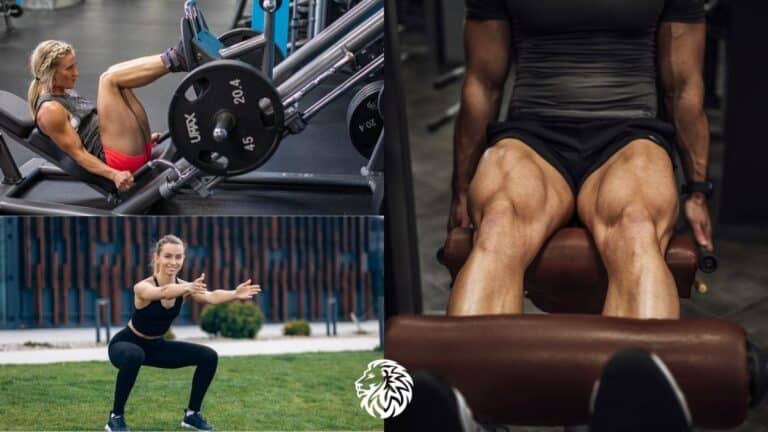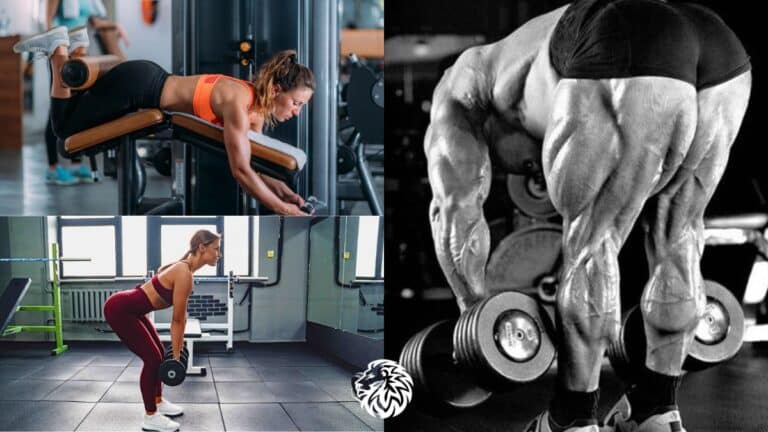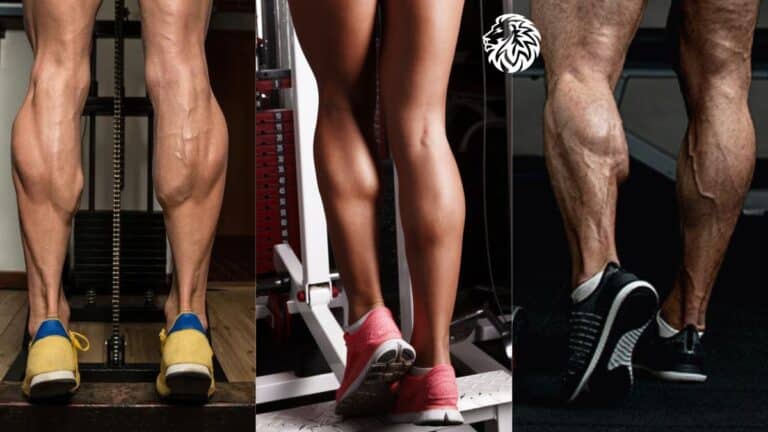The shoulders, often considered the “capstones” of the upper body, play a pivotal role in sculpting a harmonious and impressive physique. Defined, broad shoulders not only enhance the appearance of one’s silhouette but also promote better posture and aid in everyday functional movements. Their importance in bodybuilding and fitness realms cannot be understated.
However, the journey to achieving robust and well-rounded shoulders requires more than just determination; it requires the right tools and techniques. This is where cable exercises come into play. Unlike traditional free weights, cables offer a unique blend of consistent tension throughout the entire range of motion, enabling the muscles to be engaged more effectively. Moreover, cable exercises introduce versatility and reduce undue stress on the joints, making them a preferred choice for many aiming for both strength and aesthetics.
In this article, we’ll delve into the essential cable exercises that can be the game-changer in your shoulder development journey. Whether you’re a novice or a seasoned gym-goer, integrating these exercises can lead to noticeable gains and a more balanced overall look.
Anatomy of the Shoulders
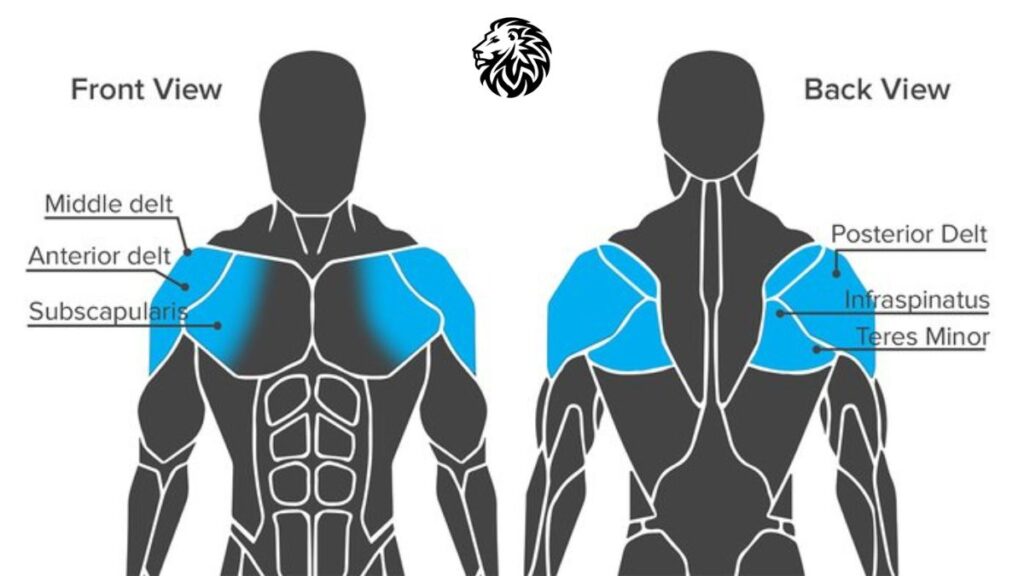
The shoulder, a complex and intricate joint, boasts a range of motion wider than any other in the human body. Central to this joint’s muscular architecture is the deltoid muscle, which cloaks the shoulder and gives it its characteristic rounded contour. The deltoid is not a singular, homogenous muscle but is composed of three distinct fibers or “heads” that collaborate to facilitate various arm movements. Understanding these heads is crucial for targeted training and achieving a well-proportioned shoulder.
- Anterior Deltoid (Front Delt)
- Location: This muscle head originates from the anterior border of the clavicle and is located at the front of the shoulder.
- Function: Primarily responsible for shoulder flexion, it assists in raising the arm forward and plays a role in inward rotation of the arm.
- Medial Deltoid (Lateral Delt)
- Location: Situated on the side of the shoulder, it originates from the acromion of the scapula.
- Function: This segment of the deltoid is vital for abducting the arm or raising it out to the side. A well-developed medial deltoid contributes to the sought-after “broad shoulder” appearance.
- Posterior Deltoid (Rear Delt)
- Location: Positioned at the back of the shoulder, this head arises from the spine of the scapula.
- Function: It plays a primary role in shoulder extension, helping to move the arm backward, and also aids in the outward rotation of the arm.
Incorporating exercises that target each of these three deltoid heads is essential for comprehensive shoulder development, ensuring not only aesthetic balance but also functional strength and mobility. As we delve deeper into cable shoulder exercises, you’ll learn how to effectively engage each segment of this vital muscle group.
Advantages of Cable Workouts for Shoulders
Cable machines have increasingly become a staple in modern gyms, and for good reason. Their unique mechanics present several benefits, especially when targeting the multifaceted deltoid muscles of the shoulders. Let’s delve into some of the primary advantages of employing cable workouts for shoulder development:
- Constant Tension Throughout the Movement
- With free weights, the tension experienced by muscles can vary based on the movement’s angle and the pull of gravity. For instance, during a dumbbell lateral raise, the deltoids experience maximum tension only when the arms are parallel to the ground.
- In contrast, cable machines maintain a steady tension across the entire range of motion due to the pulley system. This continuous tension ensures that the deltoid muscles are engaged and activated throughout the entire exercise, leading to more effective muscle stimulation and growth.
- Versatility in Angles and Resistance
- One of the standout features of cable machines is the ability to quickly and easily adjust the pulley’s height, allowing users to target muscles from various angles. This is particularly beneficial for the shoulders, which, as discussed earlier, consist of three different heads requiring varied angles for optimal engagement.
- Additionally, the resistance can be fine-tuned to cater to individual strength levels and goals. Whether you’re aiming for muscle endurance with lighter weights and higher reps or hypertrophy with heavier weights and fewer reps, cable machines can be adapted to meet your needs.
- Reduced Stress on Joints Compared to Free Weights
- Shoulder joints, being highly mobile, are also vulnerable to injuries. Free weights, while effective, can sometimes place undue stress on these joints, especially if the form is compromised.
- Cable exercises offer a smoother motion, which can be gentler on the joints. The pulley system provides a more controlled trajectory for the weight, ensuring that the load is distributed evenly. This reduced joint stress makes it a safer option for those with existing shoulder issues or those keen on preventive measures.
Incorporating cable exercises into your shoulder routine can offer these benefits and more. While free weights undoubtedly have their place and advantages, the attributes of cable workouts make them a valuable tool in the arsenal of anyone seeking comprehensive and balanced shoulder development.
Essential Cable Shoulder Exercises
1. Cable Lateral Raise
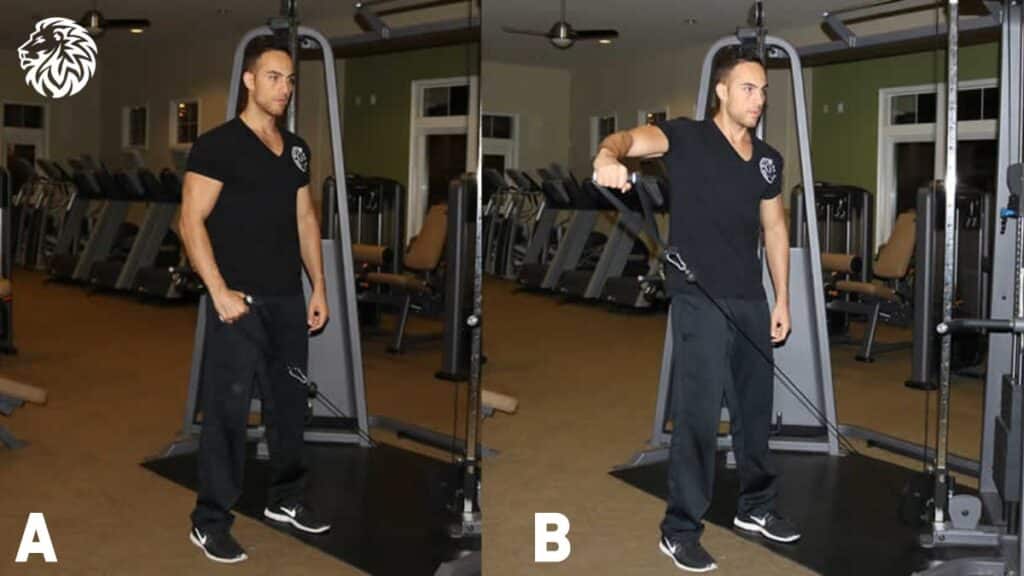
Target Muscle: Medial Deltoid
The cable lateral raise is a fantastic exercise to isolate the medial or “lateral” deltoid. By targeting this muscle head, you emphasize the width of the shoulders, contributing to that broader, V-tapered appearance.
Proper Form and Technique:
- Starting Position: Stand side-on to a cable machine with a low pulley. Hold the cable handle in the hand furthest from the machine with your feet shoulder-width apart.
- Grip and Posture: Use a neutral grip (palm facing down). Keep a slight bend in your elbow. Maintain an upright posture with your core engaged and chest up.
- Movement: Without using momentum, slowly lift the cable out to the side, keeping the slight bend in your elbow consistent. Elevate the arm until it’s parallel to the ground or slightly above. The movement should resemble an arc, with the elbow and hand moving in tandem.
- Returning: Slowly lower the weight back down in a controlled manner, ensuring you don’t let the weight stack touch down between reps.
Common Mistakes to Avoid:
- Using Excessive Weight: Lifting too heavy can cause you to use momentum or engage other muscle groups. For isolation exercises like the cable lateral raise, it’s best to use a weight that allows for controlled movement.
- Incomplete Range of Motion: Ensure you’re lifting the arm until it’s at least parallel to the ground and lowering it completely without letting the weight stack touch down.
- Leaning Away: Some people tend to lean away from the machine to help lift the weight. This reduces the effectiveness of the exercise and can strain the lower back. Always maintain an upright posture.
- Overextending the Elbows: While a slight bend in the elbow is recommended, avoid straightening the arm entirely or bending it too much, as this can reduce the tension on the medial deltoid.
2. Cable Front Raise
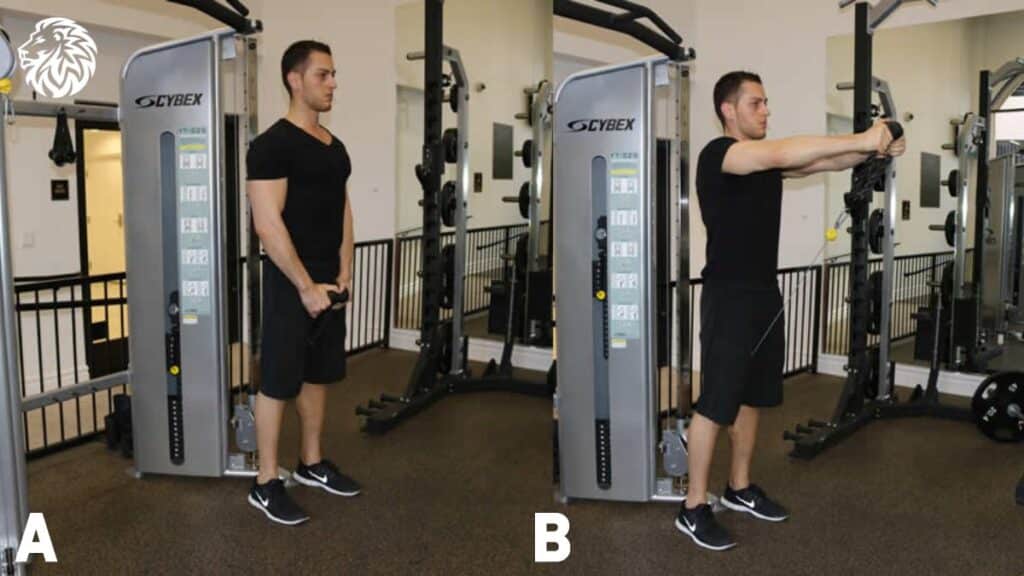
Target Muscle: Anterior Deltoid
The cable front raise targets the front or “anterior” portion of the deltoid. This exercise helps in shoulder flexion and contributes to the front shoulder’s rounded appearance.
Proper Form and Technique:
- Starting Position: Stand facing the cable machine with a low pulley. Hold the cable handle in both hands with your palms facing down. Your feet should be shoulder-width apart.
- Grip and Posture: Maintain a neutral grip and ensure your arms are fully extended but without locking the elbows. Engage your core and keep your back straight.
- Movement: With controlled motion, lift the cable handle upwards in front of you, keeping your arms extended. Raise until your arms are parallel to the ground or slightly above.
- Returning: Slowly lower the handle back to the starting position, resisting the pull of the weight.
Common Mistakes to Avoid:
- Using Excessive Momentum: Avoid using a swinging motion to lift the weight. The movement should be controlled and focused on the anterior deltoid.
- Overarching the Back: As the weight gets heavy, there might be a tendency to arch the back. Always keep the core engaged to prevent this.
- Locking the Elbows: While the arms should be mostly straight, avoid locking out the elbows completely.
3. Cable Face Pulls
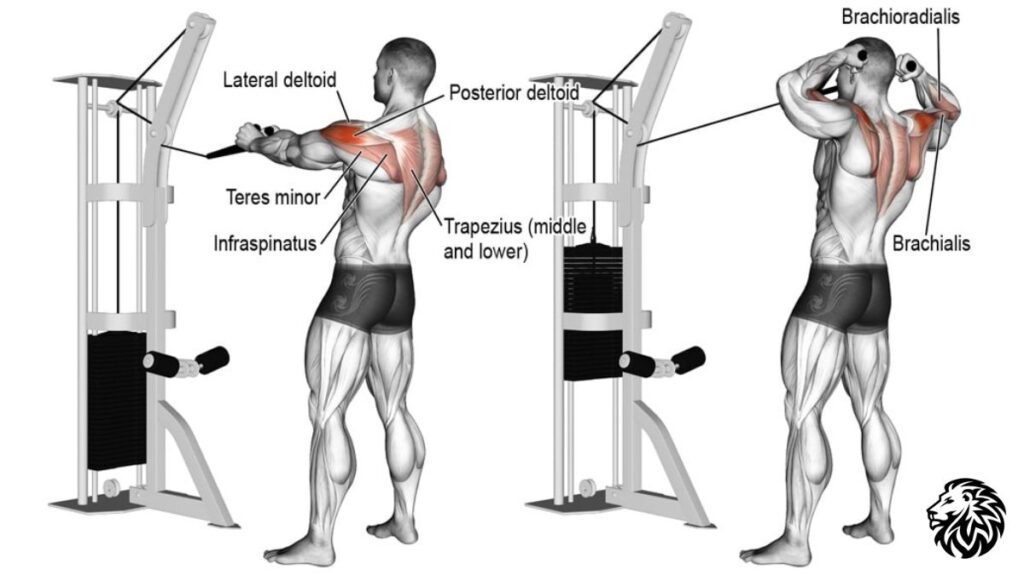
Target Muscle: Posterior Deltoid
Cable face pulls are a versatile exercise that targets the rear or “posterior” deltoid. This movement also engages the upper traps and the muscles of the upper back, making it great for overall shoulder health and posture.
Proper Form and Technique:
- Starting Position: Stand facing a cable machine with the pulley set to upper chest or face level. Use a rope attachment, holding each end with your palms facing each other.
- Grip and Posture: Start with arms extended in front of you, hands wider than shoulder-width apart. Keep your chest up and core tight.
- Movement: Pull the rope towards your face, aiming to get the ends of the rope to the sides of your ears. As you pull, focus on externally rotating your shoulders and squeezing your shoulder blades together.
- Returning: Extend your arms back to the starting position in a controlled motion.
Common Mistakes to Avoid:
- Elbow Position: Avoid letting your elbows drop too low. They should be in line with or slightly above your shoulders during the pull.
- Using the Lower Back: Avoid leaning back or using the lower back to pull the weight. Ensure the movement is isolated to the upper back and shoulders.
- Going Too Heavy: Using excessive weight can compromise form and shift the focus away from the target muscles. Choose a weight that allows for controlled, deliberate reps.
4. Cable Upright Rows
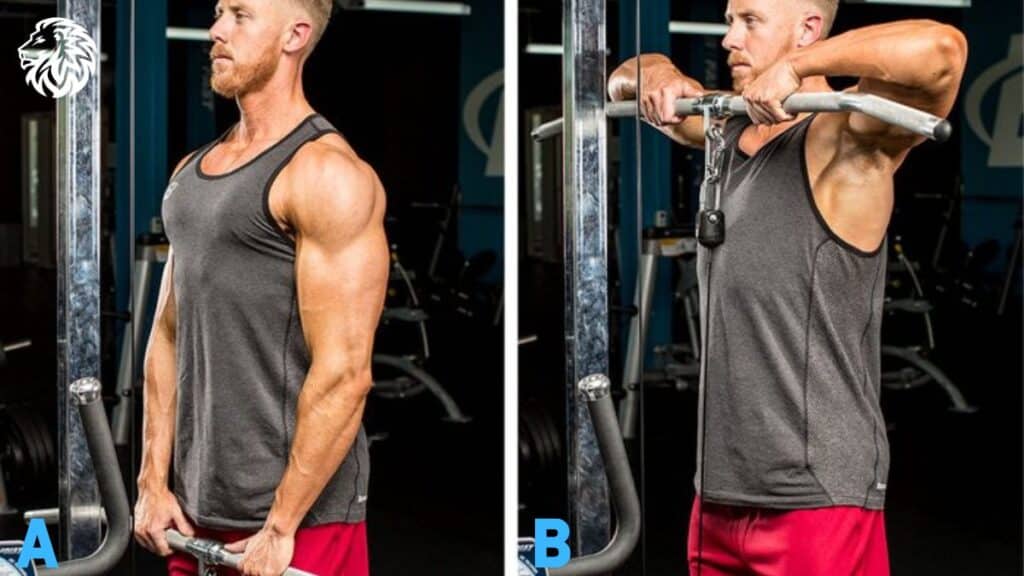
Target Muscle: Combination of Anterior and Medial Deltoids
The cable upright row is a compound movement that hits both the front and side deltoids, offering a comprehensive shoulder exercise that also engages the traps.
Proper Form and Technique:
- Starting Position: Stand facing the cable machine with a low pulley. Grip the cable bar or a straight bar attachment with hands at a narrower-than-shoulder-width grip.
- Grip and Posture: Maintain a neutral grip. Stand tall with a straight back, keeping your feet shoulder-width apart and knees slightly bent.
- Movement: Lift the bar by leading with the elbows, pulling it straight up towards your chin. Your elbows should always be higher than your wrists during the movement.
- Returning: Lower the bar back down to the starting position in a controlled manner.
Common Mistakes to Avoid:
- Wrist Position: Ensure that your wrists stay straight and don’t flex excessively as you row upward.
- Excessive Weight: Using too much weight can cause you to lean back and engage the lower back. Keep the movement controlled and upright.
- Too Wide Grip: A grip that’s too wide can place undue stress on the shoulder joints. A narrower grip focuses the tension on the deltoids.
5. Cable Rear Delt Fly
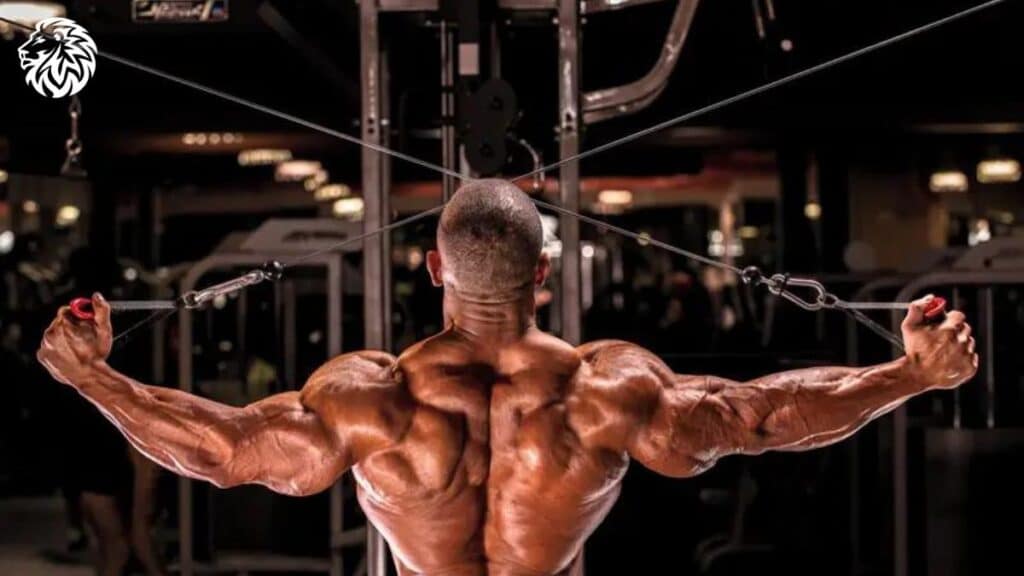
Target Muscle: Posterior Deltoid
The cable rear delt fly isolates the posterior deltoid, balancing out the shoulder’s development and promoting good posture.
Proper Form and Technique:
- Starting Position: Stand in the center of a cable crossover machine with pulleys set to head height. Grip the left cable handle with your right hand and the right handle with your left hand, so they are crossed.
- Grip and Posture: Begin with arms slightly bent and extended in front of you. Stand tall with feet shoulder-width apart and a slight bend in your knees.
- Movement: With a fixed elbow bend, open your arms out to the sides, squeezing the shoulder blades together as you reach the end of the movement.
- Returning: Slowly bring the arms back to the starting position, maintaining the cross of the cables and resisting their pull.
Common Mistakes to Avoid:
- Using Excessive Weight: This can lead to momentum-driven movements or engaging the traps excessively. The focus should be on the posterior deltoids.
- Overextending the Elbows: Keep a slight, consistent bend in the elbows throughout the movement.
- Rounding the Back: Maintain an upright posture with the chest up and shoulder blades retracted.
Tips for Maximizing Shoulder Development with Cables

The versatility and unique tension curve of cables make them an excellent tool for shoulder development. To get the most out of your cable shoulder workouts, follow these essential tips:
- Importance of Proper Warm-up:
- Why: The shoulder joint is complex and susceptible to injury. A proper warm-up increases blood flow to the muscles, enhances joint mobility, and prepares the body for the workout, reducing the risk of injury.
- How: Begin with 5-10 minutes of light cardio (like jumping jacks or brisk walking) to elevate the heart rate. Follow this with dynamic stretches and mobility exercises targeting the shoulders, such as arm circles or shoulder swings.
- Adjusting Cable Height for Optimal Tension:
- Why: Adjusting the pulley height ensures that the tension is appropriately targeted to the desired deltoid head, maximizing muscle engagement.
- How: For exercises like lateral raises, use a low pulley. For face pulls, set the pulley to upper chest or face level. Always ensure that the cable creates a straight line of pull against the resistance of the muscle you’re targeting.
- Progressive Overload and its Significance:
- Why: For muscle growth and strength gains, it’s crucial to gradually increase the weight or resistance over time. This concept, known as progressive overload, ensures that muscles continually adapt and grow.
- How: Start with a weight that you can comfortably lift for a set number of reps. Once you can perform more reps than your target without fatigue, it’s time to slightly increase the weight.
- Ensuring Full Range of Motion:
- Why: Utilizing a full range of motion ensures that the muscle is engaged throughout its entire length, leading to balanced development and improved flexibility.
- How: For each exercise, move through the complete movement pattern. For example, during a cable lateral raise, begin with your arm at your side and raise it until it’s parallel to the ground or slightly above. Avoid partial reps unless they are a specific part of your training program.
By integrating these tips into your cable shoulder workouts, you can optimize muscle engagement, reduce the risk of injury, and set yourself on a path to achieving well-developed and balanced deltoids. Remember, consistency in training, coupled with proper technique, is key to seeing results.
Combining Cable and Free Weight Exercises

Using a combination of cables and free weights is a strategic approach to shoulder development. Both methods have their unique benefits, and when combined, they offer a comprehensive and effective workout.
Synergy of Both Methods for Holistic Shoulder Development:
- Constant Tension with Cables: Cables provide consistent tension throughout the exercise movement, ensuring that muscles are continuously engaged. This is especially beneficial in the peak contraction and eccentric (lowering) phase of exercises.
- Stabilization and Compound Movement with Free Weights: Free weights require stabilization from supporting muscle groups. They’re excellent for compound exercises, which work multiple muscle groups simultaneously, and can help build overall muscle mass and strength.
- Versatility: Combining both allows for a wider range of exercises, targeting all heads of the deltoid (anterior, medial, and posterior) and the surrounding musculature.
- Progressive Overload: Both methods can be adjusted for progressive overload, ensuring continuous muscle growth and strength gains.
Sample Shoulder Workout Incorporating Both Cables and Free Weights:
- Warm-up:
- 5-10 minutes of light cardio
- Dynamic shoulder stretches
- Cable Lateral Raise:
- 3 sets of 12-15 reps
- Focus on the medial deltoid with constant tension.
- Dumbbell Shoulder Press:
- 3 sets of 8-12 reps
- Compound movement targeting the anterior and medial deltoids. Ensure a full range of motion, pressing the dumbbells from shoulder height to full arm extension.
- Cable Front Raise:
- 3 sets of 12-15 reps
- Target the anterior deltoid, raising the cable to parallel or slightly above.
- Dumbbell Rear Delt Fly:
- 3 sets of 10-12 reps
- Bent-over position, focusing on squeezing the posterior deltoid.
- Cable Face Pulls:
- 3 sets of 12-15 reps
- Target the posterior deltoid and upper traps. Pull the rope towards your face, emphasizing the rear deltoids.
- Barbell Upright Rows:
- 3 sets of 10-12 reps
- Targeting the anterior and medial deltoids. Pull the barbell upwards with hands close together, leading with the elbows.
- Cool Down:
- Stretching and foam rolling, focusing on the shoulder region to promote recovery.
By blending the benefits of both cable and free weight exercises, this workout offers a holistic approach to shoulder development, ensuring balanced and comprehensive muscle engagement. Always prioritize proper form and listen to your body to avoid overtraining or injury.
Conclusion
Cable exercises have emerged as a powerful tool in the realm of shoulder development. Their ability to maintain consistent tension throughout movements ensures that the shoulder muscles are constantly engaged, leading to efficient and targeted muscle growth. Furthermore, the adaptability of cables in targeting the intricate angles and portions of the shoulder makes them an invaluable asset for those aiming for a balanced and well-defined shoulder physique.
However, it’s essential to recognize that the best results often arise from a holistic approach. By synergizing the strengths of both cable and free weight exercises, one can achieve comprehensive shoulder development, tapping into the benefits of constant tension, stabilization, and compound movements.
For anyone serious about shoulder enhancement, incorporating cable exercises into your regular shoulder training routines can be transformative. Embrace the journey, prioritize form and consistency, and watch as your shoulders evolve, becoming stronger, more defined, and aesthetically balanced.
